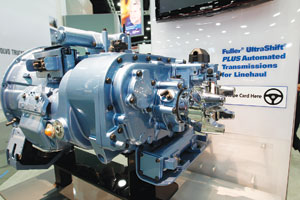Managing Editor, Features and Multimedia
Automated Transmissions Offer Fuel Savings, Driver-Retention Benefits, Study Finds

Fleets can expect to boost fuel efficiency and reduce driver turnover by adopting automated manual or fully automatic transmissions, according to a new study.
On average, automated manual transmissions provide a 1-3% improvement in fuel economy, according to the latest report released by Trucking Efficiency, a joint effort of the North American Council for Freight Efficiency and the Carbon War Room, a nonprofit organization focused on promoting business practices that reduce emissions.
In its endorsement of the technology, Trucking Efficiency said it is “highly confident” that AMTs offer a good business case for adoption today despite their higher price compared with traditional manuals.
The group said that fuel savings from fully automatic transmissions are yet to be determined, but added that they can potentially offer higher gains in certain high-shifting duty cycles.
AMTs and automatics are also easier and less tiring to drive than manuals, resulting in lower driver turnover and thus lower recruiting and training costs, the group said. At the same time, many younger people have no experience with manual transmissions.
Electronically controlled transmissions also improve safety because they better enable the driver to focus on the road in front of them, the report said.
The report said the trucking industry is at a “tipping point” in regards to the dominant transmission technology.
“Since the dawn of trucking, the vast majority of transmissions have been manual, even for decades after electronically controlled transmissions were invented and became widely adopted in passenger vehicles,” the report said. “But in the last five years, the adoption of automated manual transmissions has accelerated rapidly, from 25% to 70%, of new tractors purchased, depending on the truck builder.”
Nevertheless, there are still some barriers standing in the way of adoption of the newer technologies.
The study said AMTs cost between $3,000 and $5,000 more than manual transmissions and can make truck spec’ing more complicated.
Actual fuel-efficiency results vary depending on the application and driver performance.
Although the very best drivers are likely achieving similar results with manuals, electronically controlled transmissions reduce the variability in fuel economy from one driver to the next, thus making operating costs more predictable, the report said.
The report’s conclusions were based on interviews with all five transmission manufacturers, five truck makers and 19 large fleet owners. The study also included input from 59 small and medium-size fleets through an online collaboration with the Michelin Fleet Forum.
More details are available here.

